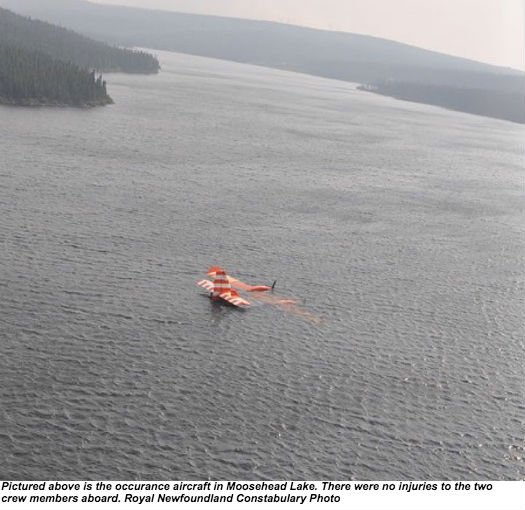TSB Press Release | August 29, 2014
Estimated reading time 2 minutes, 58 seconds.
The Transportation Safety Board of Canada (TSB) has released its report
(A13A0075) into the loss of control and collision with water of a Government of Newfoundland and Labrador Air Services Division water bomber engaged in firefighting duties. The report found that the aircraft took on too much water and failed to resume flight. The aircraft came to rest upright on the lake and partially submerged. There were no injuries to the two crew members, however the aircraft was destroyed.
On July 3, 2013, at about 2:15 p.m. Atlantic Daylight Time, the Bombardier CL-415 amphibious aircraft operating as Tanker 286, departed Wabush, Newfoundland and Labrador, to fight a nearby forest fire. Shortly after departure, Tanker 286 touched down on Moosehead Lake to scoop a load of water. About 40 seconds later, the captain initiated a left hand turn and almost immediately lost control. The aircraft came to rest upright, but partially submerged. The crew exited the aircraft and remained on the top of the wing until rescued by boat.
The TSB accident investigation found that the PROBES AUTO/MANUAL switch position check was not included on the checklist, and it is likely that the PROBES AUTO/MANUAL switch was inadvertently moved from the AUTO to MANUAL selection. The switch controls the probes, which is the equipment used to scoop water from a lake. The report warns that, if a checklist does not include a critical item, and flight crews are expected to rely on their memory, then there is a risk that the item will be missed and safety could be jeopardized.
The investigation also found that the flight crew was occupied with other flight activities during the scooping run and did not notice that the water quantity exceeded the predetermined limit until after the tanks had filled to capacity. The flight crew then decided to continue the take-off with the aircraft in an overweight condition.
Some safety action has been taken by the Government of Newfoundland and Labrador Air Services Division. Changes have been made to the storage and securement of safety gear and the installation of a portable satellite telephone in their aircraft. Water bomber pilots and maintenance personnel will be subject to new training and an increased training flight schedule. Finally, the checklist has been amended to include PROBES AUTO/MANUAL switch verification.

